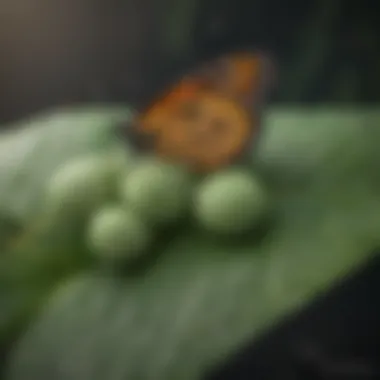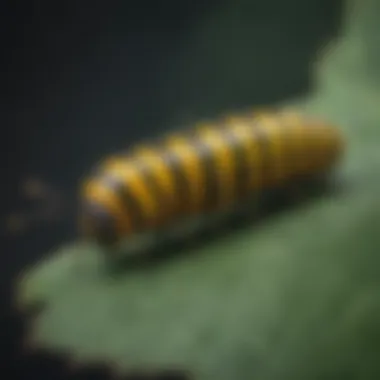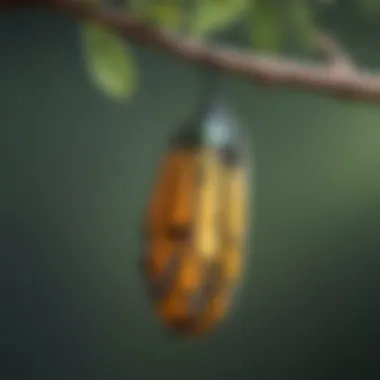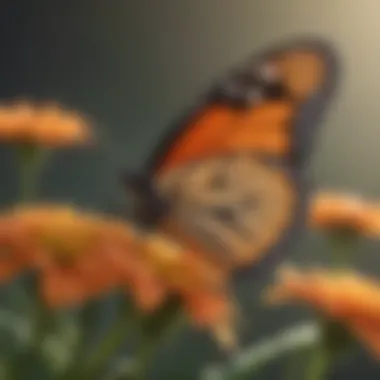Understanding Monarch Butterfly Development Stages


Intro
Monarch butterflies (Danaus plexippus) are iconic insects known for their stunning migration and striking appearance. Their life cycle is intricate, comprising distinct stages from egg to adult, each stage presenting unique biological and ecological challenges. This article aims to provide insights into the various stages of their development while highlighting the significance of these stages for conservation efforts.
Animal Species Profile
Prologue to the animal species
Monarch butterflies are perhaps the most well-known butterfly species in North America. Renowned for their remarkable migration journey, they travel thousands of miles between their breeding and wintering grounds. These insects play crucial roles as pollinators and indicators of ecosystem health.
Physical characteristics and appearance
Adult monarchs possess large, striking orange and black wings with white spots along the edges. Their coloration serves as a warning to predators, indicating their toxic nature. When viewed from above, their vivid wings are easily recognized, while the underside is brown and mottled, providing camouflage.
Natural habitat and distribution
Monarchs inhabit various ecosystems including fields, meadows, and gardens. Their range extends from southern Canada to central Mexico where they migrate each year. Their preferred host plants for laying eggs are milkweed species, which are essential for the larvae's survival.
Behavior and social interactions
Monarchs are generally solitary, coming together primarily for mating. They communicate through pheromones and visual signals during courtship. During migratory periods, they often fly in groups, although not in a coordinated manner. Their behavior is strongly influenced by environmental factors such as temperature and daylight.
Conservation & Wildlife Efforts
Overview of conservation status
The conservation status of the monarch butterfly has garnered significant attention in recent years due to a decline in their populations. According to various studies, their numbers have decreased dramatically over the past few decades.
Threats to the species
Several factors contribute to the decline of monarch populations, including habitat loss due to agricultural practices, pesticide use, and climate change. The destruction of milkweed populations and winter habitats further exacerbates these issues.
Conservation initiatives and organizations
Efforts to conserve monarch butterflies include habitat restoration programs, breeding initiatives, and public education campaigns. Organizations such as the Xerces Society and the Monarch Joint Venture are at the forefront of these efforts, working to preserve both habitats and migratory pathways.
Success stories and impact
In some regions, conservation efforts have shown positive results with increased monarch sightings. Local initiatives aimed at planting milkweed and native nectar plants have been vital in supporting the butterflies’ life cycle. These successes highlight the importance of community involvement in conservation strategies.
Unique Facts & Trivia
- Monarch butterflies can live from a few weeks to several months depending on the generation and environmental factors.
- During the winter months, monarchs cluster together in trees to maintain warmth. This behavior is crucial for their survival during cold weather.
- The caterpillar stage of the monarch can consume a vast amount of milkweed, leading to its rapid growth.
Monarch butterflies are estimated to migrate over 3,000 miles from their breeding grounds to their winter habitat in Mexico.
Finale
Understanding the stages of development in monarch butterflies is essential for appreciating their role in ecosystems and the challenges they face. By recognizing their unique life cycle and contributing to conservation efforts, we can help protect this magnificent species for future generations.
Foreword to Monarch Butterflies
The monarch butterfly is a compelling subject of study due to its intricate life cycle and notable role in various ecosystems. Understanding the stages of the monarch's development provides insights not only into their biological processes but also into broader environmental concerns. Monarchs serve as important indicators of environmental health, reflecting changes in climate and habitat. As such, learning about them is significant for conservation efforts and ecological education.


Overview of the Monarch Butterfly
Monarch butterflies, known scientifically as Danaus plexippus, are renowned for their stunning orange and black wings. These butterflies are not just visually striking; they are also migratory, traveling thousands of miles from North America to central Mexico for the winter. This remarkable migration highlights their resilience and adaptability.
In their life cycle, monarchs undergo four distinct stages: egg, larva, chrysalis, and adult. Each of these stages has unique characteristics and requirements, making it essential to study them for comprehension of their life processes. The interaction between the monarch and its environment, particularly the specific host plants crucial for caterpillar development, is a key aspect worth noting.
Importance within Ecosystems
Monarch butterflies play a vital role in the ecosystems they inhabit. As pollinators, they contribute to the reproduction of various plants, which in turn support other wildlife. Their presence indicates a well-functioning ecosystem. Increased numbers of monarchs can signify a healthy environment, while declining populations often point to underlying issues such as habitat loss or pesticide usage.
"The monarch butterfly is an archetype of the complex relationships within ecosystems, demonstrating how one species can influence others through its life stages."
Moreover, these butterflies hold cultural significance. In various regions, they are seen as symbols of change and transformation. Educational programs that emphasize the importance of monarchs help raise awareness about biodiversity and conservation needs. Addressing the challenges faced by monarch butterflies can lead to more informed actions regarding ecosystem preservation and restoration.
In summary, the study of monarch butterflies is important not just for understanding an individual species but also for recognizing the interconnectedness of life within our ecosystems. Their journey from egg to adult is a narrative of survival that reflects broader ecological changes.
The Life Cycle Stages
The life cycle stages of the monarch butterfly are crucial to its development and survival. Understanding these stages provides insights into the biological and ecological aspects of this species. The monarch’s life cycle is marked by profound transformations that showcase its adaptability and resilience. Each stage presents unique characteristics and challenges, impacting the overall health of the population.
Stage One: The Egg
Description of the Egg Stage
The monarch butterfly begins its life cycle as a small, spherical egg. These eggs are typically laid on the underside of milkweed leaves, a critical choice for the caterpillars that will hatch from them. The eggs are pale yellow in color and have a ribbed texture, which can help camouflage them against potential predators. This stage is vital because it represents the initial phase of development, blending protection and location crucial for survival.
One key characteristic of the egg stage is its vulnerability. Predators and environmental factors can easily impact this stage. In terms of benefits, careful placement on host plants increases the likelihood that the caterpillars will have access to food upon hatching.
Duration and Conditions for Development
The duration for the egg stage lasts typically around three to ten days, depending on the environmental conditions. Warmer temperatures can accelerate the hatching process, while cooler conditions may delay it. This aspect is significant since favorable conditions lead to successful hatching rates, directly affecting population dynamics.
One unique feature of this stage is the timing of the hatching. Eggs generally hatch during the peak growing season of milkweed, ensuring that resources are abundant for the emerging caterpillars. Therefore, understanding the conditions that affect this period is crucial for conservation efforts and monitoring the monarch populations.
Stage Two: The Larva (Caterpillar)
Caterpillar Development Process
After hatching, the caterpillar enters the larval stage, which is primarily focused on feeding and growth. The caterpillar will molt several times as it grows, a process known as instar. Each instar lasts a few days, with the caterpillar consuming significant amounts of milkweed during this time. This feeding phase is essential as it builds the necessary reserves for the transformation into a chrysalis.
One notable aspect of this development process is the intake of toxic compounds from milkweed, which provides the caterpillar with a defense mechanism against predators. This stage illustrates how the larva efficiently utilizes its environment for growth and protection.
Role of Host Plants
Host plants, particularly milkweed, play a crucial role in caterpillar development. The larvae rely entirely on these plants for nourishment, as milkweed is the sole food source. This dependency highlights the ecological relationships between monarch butterflies and their environment. The health of milkweed populations directly correlates with the survival and reproductive success of monarchs.
Furthermore, the chemical compounds found in milkweed contribute to the butterfly's toxicity, a characteristic inherited through the larval stage. This allows adult butterflies to deter predators more effectively. Understanding this role is imperative for habitat conservation and ensuring these crucial plants remain protected.
Stage Three: The Chrysalis (Pupa)
Transformation Process
The transformation of the caterpillar into a chrysalis is one of the most remarkable stages of monarch development. This process begins with the caterpillar attaching itself to a secure surface, where it sheds its skin to reveal the pupa. The chrysalis is green and gold, making it visually striking while also offering some camouflage.


During this stage, significant changes occur as the caterpillar’s body reassembles into a butterfly. This metamorphosis involves complex biological processes that take about ten days to complete. The chrysalis, while still, is a critical period that embodies potential.
Duration and Environmental Factors Affecting this Stage
The duration of the chrysalis stage varies, typically lasting between 7 to 14 days, contingent on temperature and moisture levels. Warmer weather tends to lead to quicker developments. Environmental factors are paramount as they can either hasten or hinder the metamorphosis. Thus, understanding these influences is vital for conservation strategies targeting monarch populations.
The chrysalis stage is particularly vulnerable to extreme weather events. High humidity or prolonged heavy rain can adversely impact the success rate of emerging butterflies. These considerations are significant as climate change poses growing threats to the delicate balance needed for this stage.
Stage Four: The Adult Butterfly
Physical Characteristics of Adults
Once the butterfly emerges from the chrysalis, it undergoes a final transformation. The adult monarch butterfly is well-known for its vibrant orange and black coloration, which serves as both a warning signal to predators and a form of identification among species.
One outstanding characteristic of adult monarchs is their impressive wingspan, which averages about three to four inches. Their physical structure enables them to migrate long distances, illustrating their adaptability in various landscapes.
Reproductive Behavior
Adult butterflies engage in reproductive behaviors that are crucial for the continuation of their species. Mating typically occurs shortly after emergence, with female butterflies laying eggs that adhere to the strategic milkweed plants.
The female's choice of host plants reflects her role in ensuring the healthy development of the next generation. One unique feature of this behavior is the long-distance migration patterns that monarchs exhibit, which enhance genetic diversity by mixing populations across vast areas. This behavior significantly impacts conservation efforts, emphasizing the need for protected migratory corridors.
Understanding the life stages of the monarch butterfly provides essential knowledge for enhancing conservation efforts. It highlights the interconnectedness between these insects and their habitats.
Physical and Behavioral Adaptations
Understanding the physical and behavioral adaptations of monarch butterflies is crucial to grasp their survival strategies and evolutionary success. These adaptations allow them to thrive in diverse environments and navigate the complex challenges they face. In this section, we will explore how these insects are equipped physically and behaviorally, enhancing their chances for survival and reproduction.
Morphological Adaptations
Monarch butterflies display several notable morphological adaptations that shape their interaction with the environment. One of the most striking characteristics is their vibrant orange and black coloration. This coloration serves a dual purpose. First, it acts as a warning signal to potential predators. The bright colors indicate that they are toxic due to the milkweed they consume during their larval stage. Hence, many birds and other predators learn to avoid them.
Furthermore, the structure of their wings is integral to their migratory behavior. Monarch wings are broad and long, allowing for efficient flight over long distances. This anatomical feature aids in their famous migration journey from North America to Mexico, spanning thousands of miles. Additionally, their body shape allows them to engage in thermoregulation, warming themselves in the sun during cool mornings before taking flight.
"Morphological adaptations such as coloration and wing structure are vital for survival and migration, illustrating the elegant design of monarch butterflies."
Another important aspect of their morphology is the presence of special structures that allow them to taste and recognize host plants. This ability is essential in locating milkweed, which the larvae require for development. Such adaptations highlight the intricate relationship between monarch butterflies and their ecosystem.
Behavioral Adaptations Across Life Stages
Behavioral adaptations play a significant role in the monarch's life cycle and are evident in each developmental stage. For instance, in the egg and caterpillar stages, the mother's choice of milkweed plants is crucial. They select leaves based on their chemical properties that will later benefit the caterpillars, ensuring they consume toxins that will fortify their defenses against predators.
During the larval stage, caterpillars exhibit feeding behaviors that maximize their growth. They consume a considerable amount of foliage, often through a strategy of selective feeding which targets leaves that are the most nutritious. This vibrant feeding behavior is essential for their transition into the chrysalis phase, as a sufficient fat reserve is necessary for metamorphosis.
Once they reach the pupal stage, monarchs exhibit a fascinating behavior of seeking safe, sheltered locations to form chrysalises. This protective action is strategic, greatly increasing their chances of survival from predation and environmental hazards.
In the adult phase, monarch butterflies undergo migratory behaviors that are remarkable. They travel long distances to find suitable breeding grounds, and they navigate using environmental cues such as sunlight and the earth's magnetic field. This migratory instinct not only connects them to breeding locations but also ensures the species' viability across generations by promoting genetic diversity.
Overall, the physical and behavioral adaptations of monarch butterflies underscore their resilience and adaptability in a changing world. By examining these aspects, we gain profound insight into their natural history and the ecological balance they help maintain.
Impact of Environmental Factors
The environmental factors play a crucial role in the life stages of monarch butterflies. These factors impact their survival rates, reproductive success, and overall population health. Understanding how elements like climate change and habitat loss affect monarchs is essential for developing effective conservation strategies.


Climate Change Effects
Climate change significantly disrupts the natural patterns that govern the life of monarchs. Rising temperatures and erratic weather patterns can alter the availability of host plants, which are critical for caterpillars' development. For instance, the milkweed plant is the sole food source for monarch larvae. If environmental changes lead to milkweed shortages, larvae may fail to thrive or even die. This situation has a direct impact on the number of butterflies that reach adulthood.
Moreover, climate change affects migration patterns. Monarch butterflies are known for their long migratory journey between North America and central Mexico. Shifting weather conditions can create barriers that interrupt this migration, resulting in poor survival rates during their journey. Decreased floral resources along the migration route also create challenges for feeding adult butterflies, further straining their populations.
Pollinator Habitat Loss
The destruction of natural habitats is another pressing issue faced by monarch butterflies. Urbanization, agriculture, and land development shrink available spaces for them to breed and feed. This loss of habitat decreases the populations not only of monarchs but also of other pollinators.
Habitats provide essential resources such as:
- Nectar-producing flowers for adult butterflies
- Host plants like milkweed for the larvae
Conservation efforts should focus on restoring these habitats. Encouraging the growth of native flora can support monarch populations and other beneficial insects. Many communities are beginning to see the value in creating butterfly gardens, which can mitigate some of the negative impacts caused by habitat destruction.
"The protection of monarch habitats is vital for maintaining biodiversity and ensuring the ecological processes that support our ecosystems."
In summary, as environmental factors continue to fluctuate, recognizing their impact on monarch butterflies becomes increasingly important. By understanding these dynamics, we can advocate for more intentional conservation efforts.
Conservation Efforts
The conservation of monarch butterflies is a crucial topic in the discussion of biodiversity and ecosystem health. Monarchs are not only a fascinating species in their own right, but they also play a vital role within their environments. Their decline is symptomatic of larger environmental issues and signals the need for urgent actions to preserve and restore their habitats.
In recent decades, populations of monarch butterflies have experienced a significant decline, primarily due to habitat loss, pesticide use, and climate change. Addressing these challenges requires comprehensive strategies that encompass various elements of conservation. The goal is not only to protect the species but also to enhance the resilience of the ecosystems they inhabit. The importance of such initiatives underscores the interconnectedness of life forms within our planet's ecosystems.
Current Initiatives for Monarchs
Conservation groups, governmental organizations, and academic institutions are actively engaged in multiple initiatives aimed at protecting monarch butterflies. Among these efforts:
- Habitat Restoration: Many organizations focus on restoring critical habitats for monarchs. This includes planting milkweed—the only host plant for monarch larvae—and other native plants to support adult butterflies. Initiatives like the Monarch Joint Venture work with landowners and communities to establish butterfly gardens and pollinator habitats.
- Pesticide Management: Advocacy for reduced use of pesticides in agriculture is crucial. Some non-profit organizations promote organic farming practices that respect beneficial insects and reduce chemical runoff into habitats where butterflies thrive.
- Research and Monitoring: Scientific research plays a key role in conservation efforts. Programs are in place to monitor monarch migration patterns, breeding sites, and population numbers. This data helps identify critical habitats and informs conservation strategies, helping ensure that efforts are effectively targeted.
- Education and Outreach: Awareness campaigns educate the public on the importance of monarch conservation. Many emphasize the role that individual gardeners can have in supporting monarch populations by creating habitats conducive to their life cycles.
"Conserving monarch butterflies doesn't just benefit them; it enhances biodiversity and promotes ecological balance."
These initiatives collectively work to create a supportive environment for monarchs, which is essential for their survival. Engaging diverse stakeholders—from schools to governments—ensures a holistic approach to conservation.
Role of Individual Actions
The actions of individuals play a vital role in the conservation of monarch butterflies. While large-scale initiatives are essential, everyday choices can significantly impact the survival of this species. Here are some ways individuals can contribute:
- Planting Native Species: Homeowners can create butterfly gardens by planting native flowers and specifically milkweed. This provides crucial resources for both adult monarchs and their larvae.
- Limiting Pesticide Use: People can reduce or eliminate pesticide use in their gardens. Choosing organic methods can help maintain healthy ecosystems that support not just butterflies but a myriad of other species as well.
- Participating in Citizen Science: Many organizations offer platforms for citizen scientists to report monarch sightings or participate in tagging programs, gathering valuable data that aids conservation efforts.
- Advocacy: Individuals can advocate for policies that protect habitats. Simple actions like contacting local representatives about supporting conservation legislation can foster larger systemic changes.
- Educating Others: Sharing knowledge about monarch butterflies with friends and family raises awareness and encourages collective action toward conservation.
By acknowledging the impact of personal actions on the environment, individuals empower themselves and others to contribute meaningfully to the survival of the majestic monarch butterfly. Each small effort can collectively lead to significant change, reinforcing the principle that conservation is both a shared responsibility and an achievable goal.
End
The conclusion of this article provides an essential summary of the intricate life stages of the monarch butterfly. Understanding these stages is not merely a pursuit of biological knowledge; it has significant implications for conservation efforts and environmental awareness. Each stage, from egg to adult, plays a critical role in the life cycle and overall survival of this iconic species.
Summary of Key Points
- The life cycle of the monarch butterfly consists of four key stages: egg, larva, chrysalis, and adult butterfly.
- Each stage requires specific environmental conditions for optimal development, underscoring the importance of habitat preservation.
- Climate change impacts and pollinator habitat loss pose significant threats to monarch populations, highlighting the need for immediate action.
- Conservation initiatives and individual actions can significantly influence the future of monarch butterflies and their ecosystems.
In essence, acknowledging the developmental phases of the monarch butterfly is vital for appreciating their role in biodiversity. It underscores the interconnectedness of life forms and the significance of maintaining ecosystems that support diverse species, including the remarkable monarch.
Future Research Directions
Future research on monarch butterflies should focus on several key areas:
- Investigating the genetic adaptability of monarchs to changing environmental conditions, including climate extremes.
- Exploring the impact of various agricultural practices on the availability of host plants and nectar sources for adult butterflies.
- Assessing the effectiveness of current conservation strategies and developing new approaches to enhance monarch habitats.
- Engaging in community outreach to raise awareness of the importance of butterflies in ecosystems, thereby fostering local conservation efforts.
By focusing on these areas, researchers can better understand the monarch butterfly's needs and inform effective conservation strategies. Addressing the challenges they face is crucial for preserving not only monarch butterflies but also the rich biodiversity they represent.







